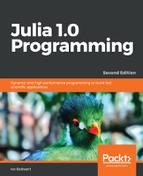The function f(x, y) at the end of the Defining functions section can also be written with no name, as an anonymous function: (x, y) -> x^3 - y + x * y. We can, however, bind it to a name, such as f = (x, y) -> x^3 - y + x * y, and then call it, for example, as f(3, 2). Anonymous functions are also often written using the following syntax (note the space before (x)):
function (x)
x + 2
end
(anonymous function)
julia> ans(3)
5
Often, they are also written with a lambda expression as (x) -> x + 2. Before the stab character (->) are the arguments, and after the stab character we have the return value. This can be shortened to x -> x + 2. A function without arguments would be written as () -> println("hello, Julia").
Here is an anonymous function taking three arguments: (x, y, z) -> 3x + 2y - z. When the performance is important, try to use named functions instead, because calling anonymous functions involves a huge overhead. Anonymous functions are mostly used when passing a function as an argument to another function, which is precisely what we will discuss in the next section.
